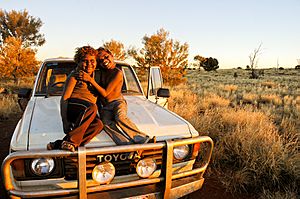Ngaanyatjarra facts for kids

Ngaanyatjarra children, 2006
|
|
| Total population | |
|---|---|
| 1,600-2,700 | |
| Regions with significant populations | |
| Australia (Northern Territory) |
|
| Languages | |
| Ngaanyatjarra, English, Pitjantjatjara, Yankunytjatjarra | |
| Religion | |
| Aboriginal mythology |
The Ngaanyatjarra people are an Indigenous Australian cultural group. They live in the Goldfields-Esperance region of Western Australia and also in the Northern Territory. They are sometimes called the Nana.
Contents
Ngaanyatjarra Language
The Ngaanyatjarra language is part of the Western Desert language family. It belongs to the Wati branch of the Pama-Nyungan languages. The word Ngaanya means "this" and -tjarra means "with" or "having". So, "Ngaanyatjarra" means "those who use 'ngaanya' to say 'this'". Many Ngaanyatjarra people speak several languages. They speak English and other local dialects.
Ngaanyatjarra Country
The lands of the Ngaanyatjarra people are very large. They cover about 3% of Australia. This area is as big as the United Kingdom! It is mostly desert. The nearest big towns, Alice Springs and Kalgoorlie, are about 1,000 kilometers away.
The Ngaanyatjarra lands are next to the lands of the Martu and Pitjantjatjara tribes. They stretch across parts of the Great Sandy Desert, the Gibson Desert, and the Great Victoria Desert.
Local Government and Communities
The Shire of Ngaanyatjarraku is the local government for this area. It covers a huge space of about 159,948 square kilometers. The Shire council helps provide services to the communities. The Ngaanyatjarra Council also runs different services for the people.
There are 10 small communities within the Ngaanyatjarra Lands:
Two other communities, Kiwirrkurra and Yilka (Cosmo Newbery), are just outside the Lands. But the Shire still helps them.
Time Zones in the Lands
The Ngaanyatjarra lands use two different time zones. Some communities, like Yilka/Cosmo, Mantamaru/Jameson, Patjarr, Tjirrkarli, Wanarn, and Warburton, use Australian Western Standard Time (AWST). Other communities, such as Blackstone, Kiwirrkurra, Tjukurla, Warakurna, and Irrunytju/Wingellina, use Australian Central Standard Time.
People and Society
People have lived in the Ngaanyatjarra area for about 10,000 years. In traditional society, the Ngaanyatjarra lived in small groups. These groups usually had about a dozen people.
Young men, called tjilku, went through a special training system to become wati (men). This training taught them important knowledge and traditions. After this training, they could wear a red headband. Even after becoming men, they continued to learn from older, wise people. Learning these traditions meant they also helped provide food for the elders.
Girls also learned about the tjukurrpa, which is the law and lore of the Dreamtime. This knowledge is very important to the Ngaanyatjarra people. People gain more knowledge as they get older. An elder who knows a lot is called a wati yirna or tjilpi.
The Ngaanyatjarra people have a special way of organizing their families, called a moiety system. It divides people into two main groups: the sun-side (Tjirntulukultul(pa)) and the shade-side (Ngumpalurrungkatja). These groups help decide who can marry whom and how children fit into the family system.
There are about 1,600 Ngaanyatjarra people who live in the area permanently. Up to 2,700 people might be counted if you include those of Ngaanyatjarra descent who visit often.
History of Contact
For a long time, the Ngaanyatjarra people had little contact with the outside world. The first outside group to set up something on their lands was the Warburton Mission in 1934. Until the 1960s, their way of life was not greatly disturbed. The mission brought Christian culture, which is still present today.
Native Title Claim
The Ngaanyatjarra people made a claim for native title over their traditional lands. On June 29, 2005, this claim was successful. The Federal Court recognized their native title rights over a huge area of about 187,000 square kilometers in Western Australia. This was a very important moment in Australian history for Indigenous land rights.
Notable People
- Tjapartji Kanytjuri Bates (circa 1933–2015), a famous artist.
See also

